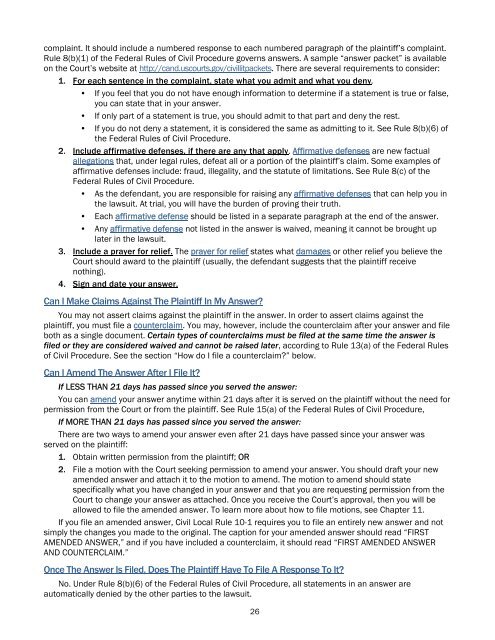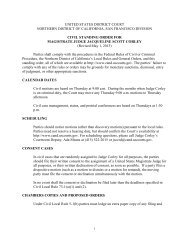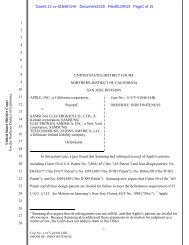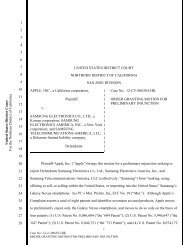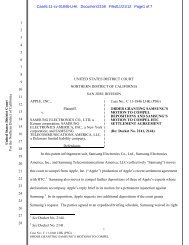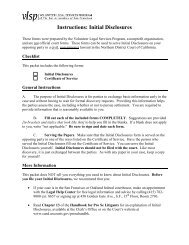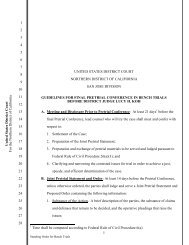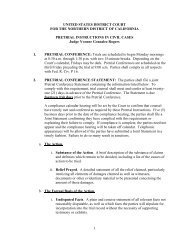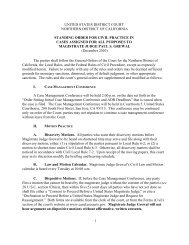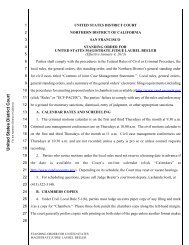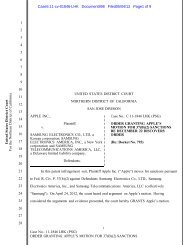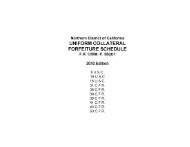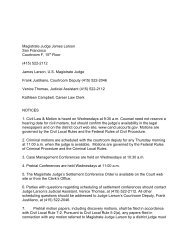Representing Yourself in Federal Court - United States District Court ...
Representing Yourself in Federal Court - United States District Court ...
Representing Yourself in Federal Court - United States District Court ...
You also want an ePaper? Increase the reach of your titles
YUMPU automatically turns print PDFs into web optimized ePapers that Google loves.
compla<strong>in</strong>t. It should <strong>in</strong>clude a numbered response to each numbered paragraph of the pla<strong>in</strong>tiff’s compla<strong>in</strong>t.<br />
Rule 8(b)(1) of the <strong>Federal</strong> Rules of Civil Procedure governs answers. A sample “answer packet” is available<br />
on the <strong>Court</strong>’s website at http://cand.uscourts.gov/civillitpackets. There are several requirements to consider:<br />
1. For each sentence <strong>in</strong> the compla<strong>in</strong>t, state what you admit and what you deny.<br />
• If you feel that you do not have enough <strong>in</strong>formation to determ<strong>in</strong>e if a statement is true or false,<br />
you can state that <strong>in</strong> your answer.<br />
• If only part of a statement is true, you should admit to that part and deny the rest.<br />
• If you do not deny a statement, it is considered the same as admitt<strong>in</strong>g to it. See Rule 8(b)(6) of<br />
the <strong>Federal</strong> Rules of Civil Procedure.<br />
2. Include affirmative defenses, if there are any that apply. Affirmative defenses are new factual<br />
allegations that, under legal rules, defeat all or a portion of the pla<strong>in</strong>tiff’s claim. Some examples of<br />
affirmative defenses <strong>in</strong>clude: fraud, illegality, and the statute of limitations. See Rule 8(c) of the<br />
<strong>Federal</strong> Rules of Civil Procedure.<br />
• As the defendant, you are responsible for rais<strong>in</strong>g any affirmative defenses that can help you <strong>in</strong><br />
the lawsuit. At trial, you will have the burden of prov<strong>in</strong>g their truth.<br />
• Each affirmative defense should be listed <strong>in</strong> a separate paragraph at the end of the answer.<br />
• Any affirmative defense not listed <strong>in</strong> the answer is waived, mean<strong>in</strong>g it cannot be brought up<br />
later <strong>in</strong> the lawsuit.<br />
3. Include a prayer for relief. The prayer for relief states what damages or other relief you believe the<br />
<strong>Court</strong> should award to the pla<strong>in</strong>tiff (usually, the defendant suggests that the pla<strong>in</strong>tiff receive<br />
noth<strong>in</strong>g).<br />
4. Sign and date your answer.<br />
Can I Make Claims Aga<strong>in</strong>st The Pla<strong>in</strong>tiff In My Answer?<br />
You may not assert claims aga<strong>in</strong>st the pla<strong>in</strong>tiff <strong>in</strong> the answer. In order to assert claims aga<strong>in</strong>st the<br />
pla<strong>in</strong>tiff, you must file a counterclaim. You may, however, <strong>in</strong>clude the counterclaim after your answer and file<br />
both as a s<strong>in</strong>gle document. Certa<strong>in</strong> types of counterclaims must be filed at the same time the answer is<br />
filed or they are considered waived and cannot be raised later, accord<strong>in</strong>g to Rule 13(a) of the <strong>Federal</strong> Rules<br />
of Civil Procedure. See the section “How do I file a counterclaim?” below.<br />
Can I Amend The Answer After I File It?<br />
If LESS THAN 21 days has passed s<strong>in</strong>ce you served the answer:<br />
You can amend your answer anytime with<strong>in</strong> 21 days after it is served on the pla<strong>in</strong>tiff without the need for<br />
permission from the <strong>Court</strong> or from the pla<strong>in</strong>tiff. See Rule 15(a) of the <strong>Federal</strong> Rules of Civil Procedure,<br />
If MORE THAN 21 days has passed s<strong>in</strong>ce you served the answer:<br />
There are two ways to amend your answer even after 21 days have passed s<strong>in</strong>ce your answer was<br />
served on the pla<strong>in</strong>tiff:<br />
1. Obta<strong>in</strong> written permission from the pla<strong>in</strong>tiff; OR<br />
2. File a motion with the <strong>Court</strong> seek<strong>in</strong>g permission to amend your answer. You should draft your new<br />
amended answer and attach it to the motion to amend. The motion to amend should state<br />
specifically what you have changed <strong>in</strong> your answer and that you are request<strong>in</strong>g permission from the<br />
<strong>Court</strong> to change your answer as attached. Once you receive the <strong>Court</strong>’s approval, then you will be<br />
allowed to file the amended answer. To learn more about how to file motions, see Chapter 11.<br />
If you file an amended answer, Civil Local Rule 10-1 requires you to file an entirely new answer and not<br />
simply the changes you made to the orig<strong>in</strong>al. The caption for your amended answer should read “FIRST<br />
AMENDED ANSWER,” and if you have <strong>in</strong>cluded a counterclaim, it should read “FIRST AMENDED ANSWER<br />
AND COUNTERCLAIM.”<br />
Once The Answer Is Filed, Does The Pla<strong>in</strong>tiff Have To File A Response To It?<br />
No. Under Rule 8(b)(6) of the <strong>Federal</strong> Rules of Civil Procedure, all statements <strong>in</strong> an answer are<br />
automatically denied by the other parties to the lawsuit.<br />
26


